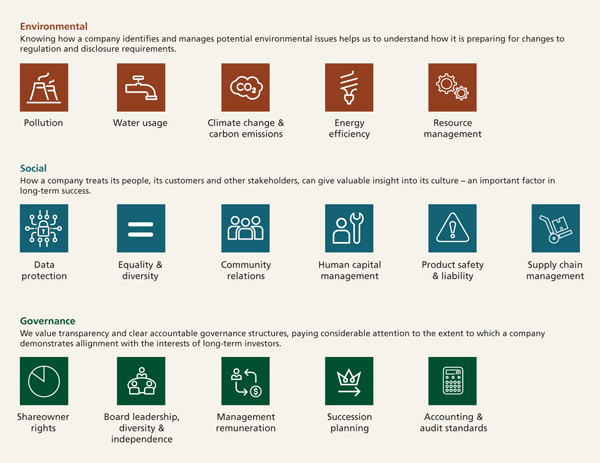Emerging markets investing – putting sustainability front and centre
Written By:

|
David Sheasby |

|
Kim Catechis |
David Sheasby and Kim Catechis of Martin Currie identify the ESG factors that should be assessed when considering investment in emerging markets
ESG (environmental, social and governance), and the kindred concept of sustainability, have become firmly embedded in investor parlance for good reasons. Numerous studies, not to mention recent high-profile corporate failings, have demonstrated the impact that these, often qualitative, factors can have on the long-term business performance and thus risk-adjusted returns to investors.
Critically, although ESG analysis has historically been seen as a risk-management tool, there has been an increasing realisation that companies at the forefront of sustainability often make for better long-term investments. The argument is robust – businesses that are aligned with best practice are likely to enjoy better customer loyalty and pricing power, which ultimately translates into a healthier bottom line and cash flows. In other words, it is a source of competitive strength and therefore has to feature in a fiduciary’s assessment of a company’s prospects. It is worth noting that overly strict screening can sometimes lead to the exclusion of companies that may be starting from a low base but, nonetheless, are making significant progress. While at a more nascent stage, all of these points are as relevant in emerging markets (EM) as they are in their developed counterparts.
Figure 1: Key factors to consider
Source: Martin Currie
Materiality should be the yardstick when conducting this type of analysis and, needless to say, the relevant indicators will vary a great deal from industry to industry. By way of illustration, when meeting companies in the materials and energy sectors, investors are likely to place a significant emphasis on carbon management, due to their resource intensity and exposure to ever more stringent climate-related regulation, whereas employee relations will be important when assessing a retailer which may have a complex supply chain and a large customer-facing workforce. Governance aspects such as management remuneration and board composition are naturally of broader significance. As the global financial crisis so amply illustrated, the premises of many incentive structures have been fundamentally flawed, encouraging short-termism and risk-seeking behaviour, at the expense of long-term shareholders.
Avoiding the one-size-fits-all approach in EM
As alluded to, while EM companies in aggregate may still lag their developed market counterparts, particularly in the areas of disclosure and shareholder engagement, the picture is far from uniform. Indeed, the understanding of best practice continues to evolve, and many EM management teams have fully recognised that poor performance when it comes to ESG, not only impacts their access to capital but is also fundamentally intertwined with long-term business prospects. The scope for companies to cut corners, for example by ignoring labour conditions or skirting environmental regulation, is thankfully narrowing. This also applies across company supply chains, with an increasing awareness of the reputational damage – think the Rana Plaza factory disaster in Bangladesh or the deaths at Foxconn in China – that can follow weak standards and controls.
Assessing a company’s corporate governance structure is not always straightforward in an EM context. This contrasts with developed markets, where governance to some extent has been reduced to a box-ticking exercise. Needless to say, the developed market approach is adapted to a world in which equity ownership is heavily institutionalised and where there is clear separation between the managers of a business and its owners, as represented by the board. However, this is rarely the case in EM. As an example, many Asian companies are still characterised by owner management, reflecting their family origins, or by a significant government shareholding. In these situations, a narrow application of developed market governance ideals is not sensible, and a more flexible approach may be needed – including a qualitative assessment of a company’s governance record, conversations with management and the board, and attendant analysis of the degree to which interests are aligned.
Climate change & environment – EM showing leadership
There are a couple of very consequential recent sustainability-related developments worth highlighting, one being the ratification of the Paris Agreement on climate change on 4 October – much faster than many observers had anticipated. Although the jury may still be out on the ultimate aggressiveness of emission cuts, this clearly signalled momentum behind the critical long-term decarbonisation of the global economy. This was of course followed by the US election, the outcome of which defied expectations and potentially puts important issues in play including inequality, tax reform, healthcare affordability and the move towards clean energy. While it is too early to tell, the long-term course and timing of ESG-relevant policies could thus be materially altered under Donald Trump, both domestically and internationally.
In contrast, China last year released its draft 13th five-year plan covering the period 2016–20. Without a doubt, the highlight is the plan’s treatment of the environment, which is the subject of 16 of the 33 targets set. All 16 are mandatory, putting pressure on central and local officials to reduce energy usage, protect land, improve waterways and reduce air pollution. China is also taking steps to develop carbon and pollution markets, with regional pilot projects under way and a national emissions trading system planned for 2017. Continued government-led efforts will have widespread implications for industries throughout China and this is something investors need to watch closely. With the US heading into potential reverse when it comes to environmental leadership, it has been encouraging to see EM picking up the mantle here.
No shortcuts to sustainability
ESG needs to sit alongside traditional financial analysis when assessing the prospects for companies, and should feature prominently in company engagement. This conclusion is not derived from values-based considerations, but simply the observation that these factors clearly correlate with business performance in the long term. A blinkered approach does not only expose investors to higher risk, but can obscure the performance boost that sustainability leadership can bring. This applies as much in emerging markets as it does in developed ones, although the analysis in the former has to be calibrated to the local and regional context. A market enamoured with the short term may not assign a proper weight to these factors as they tend to manifest over the long haul. In our view, this is not wise. There are no shortcuts when it comes to sustainability and we believe the time and energy spent on these matters results in better investment decisions and thus, ultimately, more robust portfolios.
More Related Content...
|
|
|






